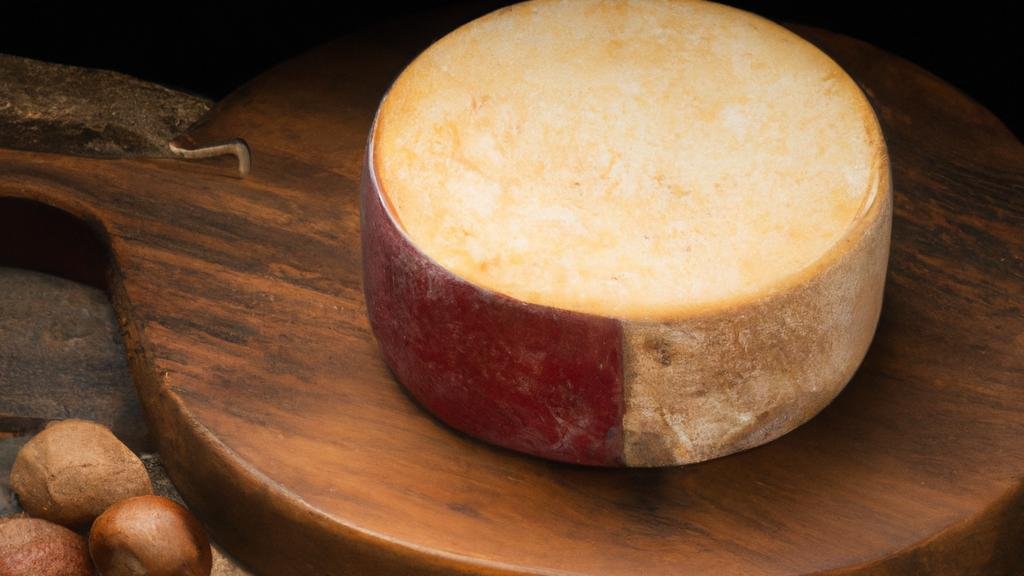
Unveiling the Uniqueness of Kashkaval: Bulgaria’s Cheese Crown Jewel
The global cheese tableau offers a rich variety, each with its unique flavor profile, texture, and historical anecdotes. Sitting majestically among these cheese varieties is Kashkaval, a semi-hard, yellow cheese steeped in culinary tradition specifically within the Bulgarian, Balkan, and Mediterranean countries. This treasured Bulgarian cheese’s charm extends far beyond the borders of Bulgaria, captivating palates globally with its distinctive flavor and versatile usage.
Kashkaval derives its name from the Italian word ‘caciocavallo,’ which translates to ‘cheese on horseback.’ The name beautifully signifies the torpedo-like shape of the cheese while curiously reflecting its method of production where it is hung to drip and age. Made traditionally from sheep’s milk, Kashkaval also comes in cow and goat milk versions, varying slightly in taste and texture. The sheep’s milk version is richer and tangier, the cow’s milk version is milder, while the goat’s milk Kashkaval owns a strong aromatic profile.
Characterized by its pale yellow hues and compact texture, Kashkaval possesses an earthly allure. The cheese is notable for its slightly open texture, with small holes or eyes scattered throughout its mass. The taste of Kashkaval is compelling, presenting itself as salty and tangy with a subtle hint of sweetness that teases the palate. Moreover, the cheese has a slightly malleable, rubbery texture that adds depth to its eating experience.
What sets Kashkaval apart is not just its intriguing flavour and texture, but also its versatility in culinary applications. Here’s a glance at the starring roles Kashkaval plays in various dishes:
- Its excellent melting properties make it ideal for grilling and an excellent topping for pizzas, lasagnas, and sandwiches.
- In traditional Bulgarian cuisine, Kashkaval is often featured in Shopska salad, a flavorful salad of diced vegetables, topped with Kashkaval cheese.
- Kashkavalka, a popular dish where the cheese is wrapped in a slice of bread and then fried, showcases Kashkaval’s flavourful depth.
- As a standalone snack or appetizer, it is often served cut into cubes alongside a glass of Rakia, the traditional Bulgarian spirit.
In the realm of cheese, Kashkaval represents a delightful union of history, culture, texture, and flavor. Its lingering taste and culinary adaptability make it an exceptional member of the global cheese repertoire, worthy of unreserved admiration and consumption.

Israel's Kashkaval Cheese Knowledge Test
Welcome to our quiz about Kashkaval cheese from Israel! Explore your taste buds and your knowledge on this savory delicacy that plays a major role in Israeli cuisine. Are you ready to plunge into the rich, yellow world of Kashkaval cheese? Let's begin!
A Delectable Journey Through the World of Kashkaval Cheese
The Kashkaval cheese, a versatile and vibrant player in the culinary world, hails primarily from the Balkans, particularly Bulgaria, Macedonia, Romania, and Albania. It is renowned for its distinctive and titillating taste. This full-fat, yellow-hued delight is generally made from cow, sheep, or buffalo milk, granting it varying degrees of richness and a diverse range of delectable characteristics. Like any delicacy worthy of the title, the allure of Kashkaval lies in its variable nature and regional interpretations, rendering it a marvelous exploration for any gastronome.
At its core, Kashkaval cheese boasts an exceptional semi-hard, slightly elastic texture that can vary between creamy and firm. It is often made through a process using rennet, which partly coagulates fresh milk, causing it to curdle and rampeting up the cheese’s distinct tanginess. This distinct quality allows it to hold its own in a multitude of culinary applications, from sandwiches, salads, and pasta dishes to appetizers and main courses. Bear in mind that its flavor intensifies when the cheese is aged. With an aging period of between three to six months, the Kashkaval develops a robust, more profound taste with a hint of sharpness and an appetite-enticing aroma.
In the realm of Kashkaval, variety reigns with different types originating from distinct areas and methods of preparation. Let’s delve into a quick snapshot of its rich array:
- Kashkaval Preslav: Hailing from Bulgaria, this version is made from ewe’s milk, presenting a slightly softer texture and a pronounced, full-bodied aroma.
- Kashkaval Panagyurski: Another Bulgarian variant, this cheese is made from cow’s milk and boasts a more subtle, slightly sweet flavor.
- Kashkaval Balkan: This type is made primarily in the Serbian and Macedonian regions using cow, sheep, or buffalo milk. Depending on the source of the milk, the flavor can range from sweet and delicate to robust and tangy.
- Kashkaval Vitosha: Named after the mountains near Sofia, Bulgaria, this version uses a blend of cow and sheep milk, yielding a uniquely mild and harmonious character.
With this knowledge at hand, embarking on a gastronomic sojourn through the nuanced world of Kashkaval cheese can awaken aficionados to tantalizing flavors and textures that encapsulate the richness of Balkan culinary tradition. The cheese’s versatile nature serves as a testament to its timeless appeal – whether consumed raw, melted, or cooked, the complex narrative of Kashkaval unfolds on the palette, revealing its culinary magnificence in countless ways.
The Origins of Kashkaval: A Journey through Bulgaria’s Traditional Cheese
When it comes to exploring the world of cheese, Bulgaria is not to be overlooked. With its rich history of dairy production dating back centuries, the country has gained recognition for its superior quality cheeses. Among the diverse range of Bulgarian cheeses, one that stands out in particular is Kashkaval. This semi-hard cheese has become a staple in Balkan cuisine and is beloved by locals and food enthusiasts alike.

Kashkaval originated in Bulgaria and has been produced in the region for centuries. The cheese is made from sheep’s milk, although variations using cow’s or goat’s milk can also be found. The cheese-making process involves heating the milk and adding rennet to separate the curds from the whey. The curds are then cut and heated again to remove more whey before being pressed into molds. The cheese is aged for several months, allowing it to develop its distinctive flavor and texture.
What sets Kashkaval apart from other cheeses is its unique taste profile. It has a smooth and creamy texture, with a slightly salty and nutty flavor. Its aroma is rich and robust, making it a favorite addition to many Mediterranean dishes. Kashkaval is incredibly versatile and can be enjoyed in a variety of ways: grated over pasta, melted in sandwiches, or simply enjoyed on its own with a glass of wine.
One of the reasons Kashkaval has gained popularity both domestically and internationally is its exceptional quality. Bulgarian cheese producers take great pride in their craft, using traditional methods and high-quality ingredients to ensure an unforgettable taste experience. The country’s favorable climate and fertile soil provide ideal conditions for dairy farming, resulting in delicious milk that serves as the foundation for exceptional cheeses like Kashkaval.
- Kashkaval is a traditional Bulgarian cheese that has been produced for centuries.
- The cheese is made from sheep’s milk, although variations using cow’s or goat’s milk can also be found.
- Kashkaval has a smooth and creamy texture, with a slightly salty and nutty flavor.
- It is incredibly versatile and can be enjoyed in a variety of ways, such as grated over pasta or melted in sandwiches.
- Bulgarian cheese producers take great pride in their craft, using traditional methods and high-quality ingredients.
Facts and figures
- Kashkaval cheese is popular in several Middle Eastern and Mediterranean countries, not just in Israel.
- One of the variants of this cheese – kashkaval vaden, is made of sheep's milk.
- This cheese has a mature, salty flavor that becomes stronger as the cheese ages.
- Kashkaval cheese is a staple in many traditional dishes in Israel.
- Depending on its age, the texture of Kashkaval can range from semi-soft to hard.
- In Israel, authentic Kashkaval is typically made in traditional cheese-making households.
- Kashkaval is known for its versatile use in both hot and cold dishes, being enjoyed in sandwiches, salads, pastas, or simply on its own.
Enhancing Gourmet Experiences with Kashkaval Cheese: Bulgarian Grilled Stuffed Peppers and Turkish Pide
Kashkaval, a delectable staple within Southeastern European cuisine, is celebrated for its rich, full-bodied flavor and melts seamlessly – making it a perfect ingredient for various gourmet creations. Two standout recipes that utilize this cheese’s versatility are Bulgarian Grilled Stuffed Peppers and Turkish Pide (a traditional dish akin to pizza), both filled with the gorgeous nuances of our star ingredient, the Kashkaval cheese. These culinary delights highlight Kashkaval’s tantalizing tanginess, drawing cheese aficionados worldwide to uncover this secret ingredient.”
The Bulgarian Grilled Stuffed Peppers offer a showcase for Kashkaval’s stringy texture when heated, with each mouthful being a burst of Balkan flavors. For four servings, you need four red bell peppers, one cup of Risotto rice, and 200 grams of finely grated Kashkaval cheese. First, prepare your stuffing by mixing the cooked rice with your cheese, along with traditional herbs – paprika, black pepper, and parsley to taste. Hollow out the peppers, fill them with your rice and cheese stuffing, and grill them to perfection. The result: an excellent main dish or sizeable side that exudes Bulgarian rusticity.
The Turkish Pide, on the other hand, is the epitome of sumptuous Middle Eastern comfort food. Start by making your own yeast dough as a base, then layer on a mixture of 250 grams of pulped tomatoes, one minced onion, 1 teaspoon of salt and pepper red pepper flakes, with the star attraction being 300 grams of Kashkaval cheese. After evenly spreading these ingredients, fold the dough’s outer layers toward the center and bake it to a golden crisp. The Kashkaval cheese will bubble and brown, emitting a delightful aroma, resulting in a warm and fulfilling Mediterranean meal.
- Recipe 1 – Bulgarian Grilled Stuffed Peppers with Kashkaval Cheese
- Ingredients: 4 red bell peppers, 1 cup of Risotto rice, 200g of Kashkaval cheese, herbs to taste.
- Method: Cook the rice. Mix it with grated cheese and herbs. Hollow out the peppers, fill them with the stuffing. Grill till perfection.
- Recipe 2 – Turkish Pide with Kashkaval Cheese
- Ingredients: Yeast dough, 250g of pulped tomatoes, 1 minced onion, 1 tsp of salt and pepper red pepper flakes, 300g of Kashkaval cheese.
- Method: Layer the ingredients on the dough base. Fold dough’s outer layers towards the center, bake till golden crisp.
Matching the Uniqueness of Kashkaval Cheese with the Perfect Wine and Cuisine Companionship
As one of the oldest types of cheese, Kashkaval stands proud with its origin in the Eastern European region, prominently Bulgaria, Macedonia, and Turkey. Known for its semi-hard texture, yellow to light brown color, and rich, salty, slightly tangy taste, Kashkaval cheese has etched its distinct presence in traditional cuisines across various cultures. As jet-set food lovers continue to explore the intermingling of different tastes and textures, they often seek the perfect pairings – the most harmonious confluence of cheese, wine, and dishes.
Marriage of Kashkaval cheese with the right wine can transform an ordinary meal into an unforgettable gastronomic experience. Red and white wines of medium body and moderate acidity are generally recommended. In reds, Merlot and Pinot Noir can be exemplary choices as they offer a velvety richness and soft tannins that complement the cheese’s salinity and full-bodied flavor. Among white wines, Chardonnay or aromatic Gewürztraminer beautifully underline the Kashkaval’s distinct features with their tantalizing fruit nuances and ample body. These wine choices embody the philosophy of either contrasting the cheese flavor (like with Gewürztraminer, which offers a sweet contrast) or complementing it (akin to Chardonnay, which boosts its creamy aspect).
Heralding its Balkan origin, Kashkaval cheese is often paired with regional dishes. Here are some inspired culinary pairings that highlight this cheese’s uniqueness:
- Kashkaval Pane: This traditional Bulgarian dish features fried Kashkaval cheese, offering a delightful crisp exterior juxtaposed with a warm, melted interior. Pair it with the freshness of Pinot Noir for a memorable partnership.
- Kashkavalka: A popular Macedonian pie made from Kashkaval cheese. Its savory character is enhanced when accompanied by an aromatic Gewürztraminer.
- Kashkaval Fondue: A twist to the traditional Swiss fondue, this Bulgarian delicacy pairs beautifully with a glass of full-bodied Merlot.
Matching wines and dishes with Kashkaval is an art – a subtle science of balancing and enhancing flavors to elevate the culinary experience. As you continue to explore this flavorful journey, remember that the perfect pairing is deeply personal and depends on individual palate preferences. Adventure, after all, is the heart of gastronomic exploration.
Similar Cheeses for Kashkaval
Kashkaval is a popular semi-hard cheese that hails from the Balkan region, particularly Bulgaria and Macedonia. It is a versatile cheese with a nutty and slightly salty flavor, making it suitable for various culinary applications. If you are a fan of Kashkaval and want to explore similar cheeses from around the world, here are a few options worth trying:
- Kasseri: Originating from Greece, Kasseri is a semi-hard cheese with a texture and flavor profile similar to Kashkaval. It is made from sheep’s milk and has a rich, buttery taste with a hint of tanginess. Kasseri is typically used in saganaki, a traditional Greek dish where the cheese is fried and served with a squeeze of lemon.
- Havarti: Hailing from Denmark, Havarti is a creamy and slightly tangy cheese that shares some similarities with Kashkaval. It has a smooth texture and a mild flavor profile, making it a versatile cheese that can be enjoyed on its own or melted in sandwiches and grilled cheese.
- Fontina: Originally from Italy, Fontina is a semi-soft cheese that can be a good substitute for Kashkaval. It has a creamy and nutty taste with a mild earthy aroma. Fontina melts beautifully, making it an excellent choice for fondue or as a topping for pizza.
- Pecorino Romano: If you prefer a more robust flavor, Pecorino Romano from Italy might be a suitable alternative to Kashkaval. Made from sheep’s milk, this hard cheese has a strong and salty taste that can add a distinctive kick to your dishes. It is commonly grated over pasta or used in traditional Italian recipes.
While these cheeses share some similarities with Kashkaval, it is important to note that each cheese has its unique characteristics. Exploring different cheeses can be an exciting culinary adventure, allowing you to discover new flavors and textures that complement your favorite dishes.

